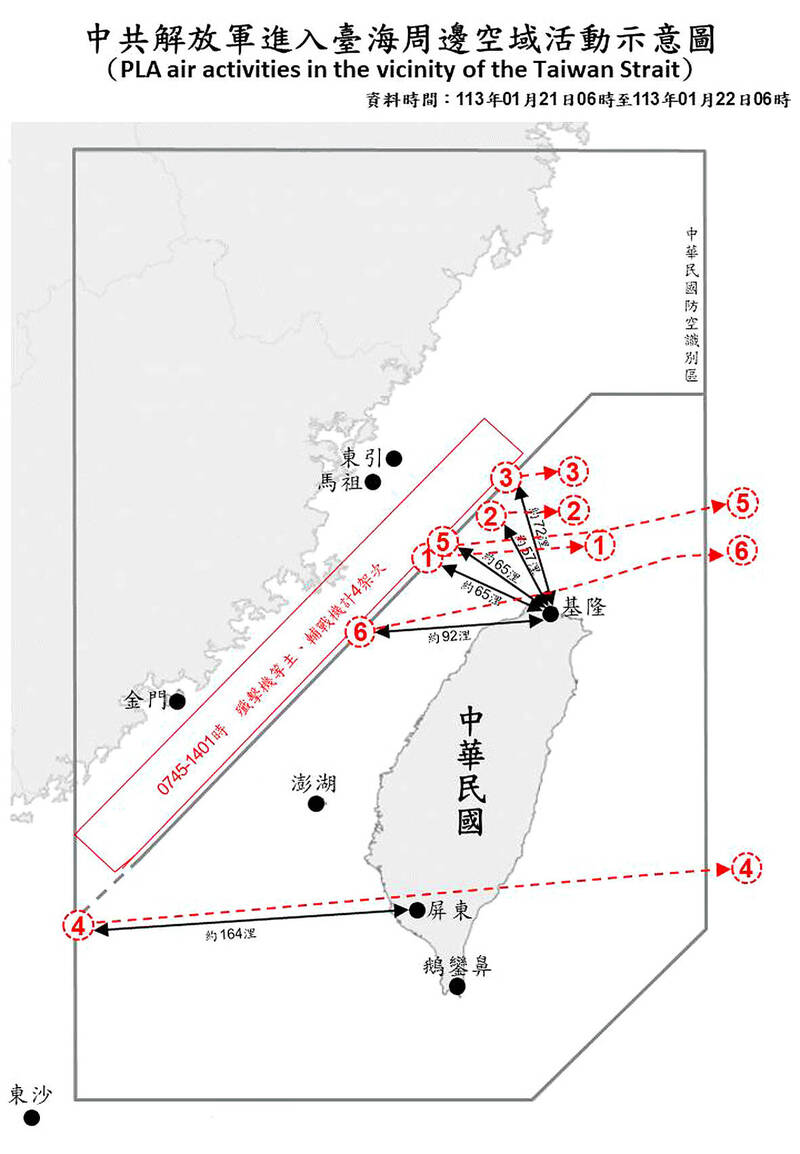《TAIPEI TIMES》FEATURE: Tracking China’s balloons over nation

A map shows activity by the Chinese People’s Liberation Army, including six balloon flights, in the 24 hours that ended at 6am on Jan. 22. Photo courtesy of the Ministry of National Defense
AVIATION HAZARD: An expert said that sending balloons over at the altitudes that China deploys them to is dangerous, because they are within air traffic corridors
By Jackie Gu and Yimou Lee / Reuters
About a month before Taiwan’s presidential election in January, China began sending intruders over the Taiwan Strait: more than 100 balloons, some of which passed through the nation’s airspace or busy air corridors for civil aviation.
Experts say the balloons could be psychological warfare, carry surveillance tools or simply gather meteorological data. On some days, as many as eight were detected within a few hours; at other times, weeks passed without any balloons at all.
In the week leading up to the election on Jan. 13, an average of three balloons were spotted each day. On April 11, they stopped altogether.
The increased frequency has raised alarms domestically and abroad.
A senior Taiwanese security official briefed on the matter said tat Chinese balloon flights near Taiwan took place on an “unprecedented scale” in the weeks leading up to the election and described the incidents as part of a Chinese pressure campaign — so-called “gray zone” warfare designed to exhaust a foe using irregular tactics without open combat.
Taiwan is to inaugurate its new president, William Lai (賴清德), on Monday. China has a strong dislike of Lai, believing him to be a dangerous “separatist.”
The Chinese Ministry of National Defense did not respond to a request for comment.
China’s Taiwan Affairs Office referred reporters to its comment on Jan. 31, in which it dismissed complaints about the balloons, saying they were for meteorological purposes and should not be hyped up for political reasons.
Before Dec. 8, balloon data were not made public, meaning that historical comparisons are impossible.
However, Mainland Affairs Council spokesman Jan Jyh-horng (詹志宏) told reporters that in the past, a balloon would be spotted “maybe once a month.”
Between December last year and last month, more than four balloons were detected on eight separate days. In total, just over 100 balloons were flown during that period.
Three Taiwanese officials briefed on the matter confirmed that the number of Chinese balloons had increased significantly in the past few months.
The majority are weather balloons collecting atmospheric data, including wind, temperature and humidity, they said, but Taiwan still sees them as Chinese harassment.
The balloons have flown at an altitude of 3.4km to 11.6km, with a mean altitude of 6.8km — well under the usual altitude for meteorological balloons.
According to the US National Weather Service, weather balloons typically reach altitudes of more than 30.5km.
“Sending them over at that kind of altitude is dangerous,” said Alexander Neill, a strategic adviser on Indo-Pacific geopolitics who was formerly at the International Institute for Strategic Studies and the Royal United Services Institute. “You are within air traffic corridors and the potential for a collision is concerning.”
Jan agreed, saying that the balloons are a threat to aviation safety.
“They fly very slowly, while planes move speedily,” he said. “It could be too late when they were spotted, if they were sucked into the engines.”
China’s most frequent form of “gray zone” activity has been the almost daily air force and navy missions in the waters and skies around Taiwan, forcing the nation’s armed forces to repeatedly scramble to see off the intruders.
Other tactics Taiwanese officials have expressed concern about include sand dredging close to Lienchiang County, which is near the Chinese coast.
A second senior Taiwanese senior security official said, citing intelligence gathered by Taiwan, that the data potentially collected by the balloons would be useful for the Chinese People’s Liberation Army’s rocket forces, because atmospheric factors could affect missile launches.
“If China was planning to mount an air assault onto Taiwan, they would need to understand the meteorological conditions and wind patterns of the island,” Neill said.
Democratic Progressive Party Legislator Wang Ting-yu (王定宇), who is co-convener of the legislature’s Foreign Affairs and National Defense Committee, told reporters that balloons are hard for military radars to detect unless their sensitivity is set to high levels.
However, ultra-sensitive radars are likely to spot objects such as birds, and as a result, Taiwan’s military might miss other vital targets such as incoming missiles.
“It’s a challenging task,” Wang said.
Raymond Kuo (郭泓均), director of the RAND Corp’s Taiwan Policy Initiative, said he thinks the purpose of the balloons is primarily psychological.
“I personally am skeptical of what additional intelligence China could get from balloons that they couldn’t get from other platforms,” Kuo said. “I think they’re mostly meant to signal to Taiwan that they can’t even defend their airspace.”
新聞來源:TAIPEI TIMES














